The Memristor Market is estimated to be valued at USD 0.4 billion in 2025 and is projected to reach USD 7.5 billion by 2035, registering a compound annual growth rate (CAGR) of 35.0% over the forecast period.
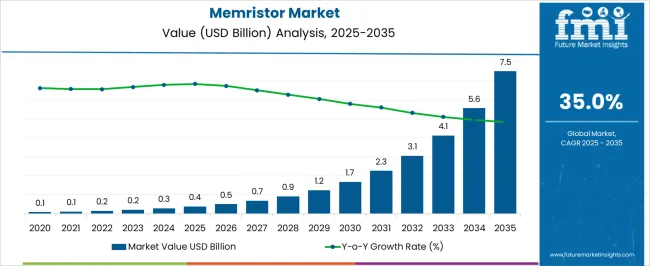
| Metric | Value |
|---|---|
| Memristor Market Estimated Value in (2025 E) | USD 0.4 billion |
| Memristor Market Forecast Value in (2035 F) | USD 7.5 billion |
| Forecast CAGR (2025 to 2035) | 35.0% |
The memristor market is experiencing accelerating growth, supported by its rising role in next-generation memory technologies and neuromorphic computing applications. Its unique ability to combine memory and processing within the same architecture is positioning it as a transformative technology across data storage, artificial intelligence, and high-performance computing. Growing demand for faster, energy-efficient, and scalable memory solutions is driving research and commercialization efforts, particularly as traditional memory technologies such as NAND and DRAM approach their physical and performance limits.
Increasing investments by semiconductor companies and research institutions are expanding pilot production and enabling advancements in material engineering and device design. The ability of memristors to deliver non-volatile, high-density, and low-power storage is gaining attention in consumer electronics, enterprise storage, and cloud computing environments.
Additionally, their potential to mimic synaptic functions is strengthening adoption in neuromorphic systems designed for advanced AI applications As global data generation surges and demand for real-time analytics intensifies, memristor technology is expected to play a pivotal role in shaping the future of computing infrastructure and memory systems.
The memristor market is segmented by based on ram, product type, and geographic regions. By based on ram, memristor market is divided into 16 GB, 4 GB, 8 GB, 32 GB, and 64 GB. In terms of product type, memristor market is classified into Dynamic RAM (D-RAM), Static RAM (S-RAM), and EPROM. Regionally, the memristor industry is classified into North America, Latin America, Western Europe, Eastern Europe, Balkan & Baltic Countries, Russia & Belarus, Central Asia, East Asia, South Asia & Pacific, and the Middle East & Africa.
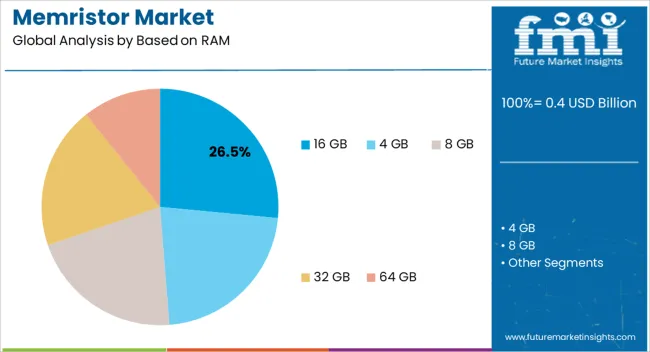
The 16 GB RAM segment is projected to capture 26.5% of the memristor market revenue share in 2025, establishing itself as a leading capacity category. This prominence is being driven by the balance it offers between performance, power efficiency, and affordability for both enterprise and consumer-level applications. The growing need for high-speed data processing and multitasking in personal computing devices, workstations, and edge servers is reinforcing demand for this capacity range.
Its suitability for a wide range of applications, from advanced gaming systems to data-intensive analytics platforms, is strengthening its market share. The ability of memristor-based 16 GB modules to deliver faster write and read cycles with lower latency compared to conventional technologies is further supporting adoption.
In enterprise environments, the 16 GB category is being recognized as a cost-effective solution that delivers scalable performance without significantly increasing system costs As applications requiring real-time processing expand across industries, this segment is expected to remain one of the most widely adopted capacity ranges, ensuring strong demand throughout the forecast period.
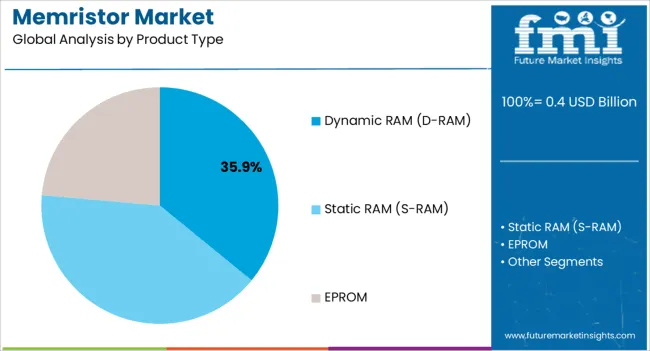
The dynamic RAM product type segment is anticipated to account for 35.9% of the memristor market revenue share in 2025, making it the dominant product category. This dominance is being reinforced by its wide-scale deployment in computing devices, data centers, and high-performance servers where high-speed memory access is critical. Dynamic RAM enhanced with memristor technology is offering significant advantages, including reduced power consumption, extended endurance, and faster processing capabilities compared to traditional DRAM.
The segment is benefiting from rapid digitalization across industries, which is increasing the demand for reliable and high-capacity memory solutions to support cloud computing, artificial intelligence, and big data applications. Its compatibility with existing system architectures is allowing smoother integration, reducing barriers to adoption for enterprises and device manufacturers.
Ongoing advancements in semiconductor fabrication processes are further enhancing the efficiency and scalability of dynamic RAM modules based on memristor technology As memory requirements continue to escalate across consumer and enterprise ecosystems, this product type is expected to maintain a strong leadership position within the global market.
Memristor is an innovative electric component consists of memory resistor, two terminal electrical component related to the magnetic flux linkage as well as electric charge. The memristor has properties of both memory element and resistor. The electrical resistance isn’t constant but it depends on current flowed through it and resistance depends on how much electric charge flowed in what direction in the past.
The device has memory history. When current flows in a direction resistance increase, and current flows in opposite direction resistance decreases. Memristors can replace the flash memory. The advanced technologies and rapid innovations enables create opportunities for the companies. The global memristor market anticipated to exhibit a significant CAGR as well as annual growth rate over the forecast period.
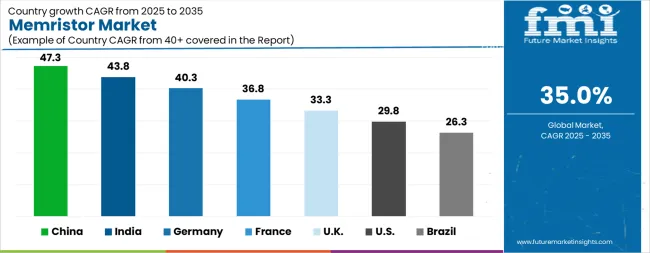
| Country | CAGR |
|---|---|
| China | 47.3% |
| India | 43.8% |
| Germany | 40.3% |
| France | 36.8% |
| UK | 33.3% |
| USA | 29.8% |
| Brazil | 26.3% |
The Memristor Market is expected to register a CAGR of 35.0% during the forecast period, exhibiting varied country level momentum. China leads with the highest CAGR of 47.3%, followed by India at 43.8%. Developed markets such as Germany, France, and the UK continue to expand steadily, while the USA is likely to grow at consistent rates. Brazil posts the lowest CAGR at 26.3%, yet still underscores a broadly positive trajectory for the global Memristor Market. In 2024, Germany held a dominant revenue in the Western Europe market and is expected to grow with a CAGR of 40.3%. The USA Memristor Market is estimated to be valued at USD 133.4 million in 2025 and is anticipated to reach a valuation of USD 1.8 billion by 2035. Sales are projected to rise at a CAGR of 29.8% over the forecast period between 2025 and 2035. While Japan and South Korea markets are estimated to be valued at USD 19.6 million and USD 11.9 million respectively in 2025.
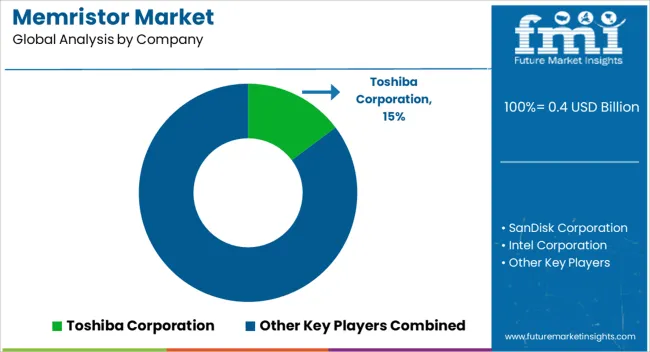
| Item | Value |
|---|---|
| Quantitative Units | USD 0.4 Billion |
| Based on RAM | 16 GB, 4 GB, 8 GB, 32 GB, and 64 GB |
| Product Type | Dynamic RAM (D-RAM), Static RAM (S-RAM), and EPROM |
| Regions Covered | North America, Europe, Asia-Pacific, Latin America, Middle East & Africa |
| Country Covered | United States, Canada, Germany, France, United Kingdom, China, Japan, India, Brazil, South Africa |
| Key Companies Profiled | Toshiba Corporation, SanDisk Corporation, Intel Corporation, Fujitsu Ltd., Samsung Electronics Co., Ltd., Cypress Semiconductor Corporation, IBM, Hewlett Packard, Seagate Technology LLC., SK Hynix, and Sony Corp |
The global memristor market is estimated to be valued at USD 0.4 billion in 2025.
The market size for the memristor market is projected to reach USD 7.5 billion by 2035.
The memristor market is expected to grow at a 35.0% CAGR between 2025 and 2035.
The key product types in memristor market are 16 gb, 4 gb, 8 gb, 32 gb and 64 gb.
In terms of product type, dynamic ram (d-ram) segment to command 35.9% share in the memristor market in 2025.






Our Research Products

The "Full Research Suite" delivers actionable market intel, deep dives on markets or technologies, so clients act faster, cut risk, and unlock growth.

The Leaderboard benchmarks and ranks top vendors, classifying them as Established Leaders, Leading Challengers, or Disruptors & Challengers.

Locates where complements amplify value and substitutes erode it, forecasting net impact by horizon

We deliver granular, decision-grade intel: market sizing, 5-year forecasts, pricing, adoption, usage, revenue, and operational KPIs—plus competitor tracking, regulation, and value chains—across 60 countries broadly.

Spot the shifts before they hit your P&L. We track inflection points, adoption curves, pricing moves, and ecosystem plays to show where demand is heading, why it is changing, and what to do next across high-growth markets and disruptive tech

Real-time reads of user behavior. We track shifting priorities, perceptions of today’s and next-gen services, and provider experience, then pace how fast tech moves from trial to adoption, blending buyer, consumer, and channel inputs with social signals (#WhySwitch, #UX).

Partner with our analyst team to build a custom report designed around your business priorities. From analysing market trends to assessing competitors or crafting bespoke datasets, we tailor insights to your needs.
Supplier Intelligence
Discovery & Profiling
Capacity & Footprint
Performance & Risk
Compliance & Governance
Commercial Readiness
Who Supplies Whom
Scorecards & Shortlists
Playbooks & Docs
Category Intelligence
Definition & Scope
Demand & Use Cases
Cost Drivers
Market Structure
Supply Chain Map
Trade & Policy
Operating Norms
Deliverables
Buyer Intelligence
Account Basics
Spend & Scope
Procurement Model
Vendor Requirements
Terms & Policies
Entry Strategy
Pain Points & Triggers
Outputs
Pricing Analysis
Benchmarks
Trends
Should-Cost
Indexation
Landed Cost
Commercial Terms
Deliverables
Brand Analysis
Positioning & Value Prop
Share & Presence
Customer Evidence
Go-to-Market
Digital & Reputation
Compliance & Trust
KPIs & Gaps
Outputs
Full Research Suite comprises of:
Market outlook & trends analysis
Interviews & case studies
Strategic recommendations
Vendor profiles & capabilities analysis
5-year forecasts
8 regions and 60+ country-level data splits
Market segment data splits
12 months of continuous data updates
DELIVERED AS:
PDF EXCEL ONLINE

Thank you!
You will receive an email from our Business Development Manager. Please be sure to check your SPAM/JUNK folder too.
Chat With
MaRIA